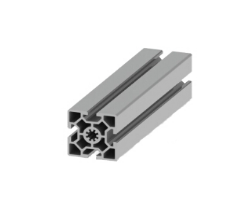Aluminum profiles are characterized in that the properties and temperature of each part of the metal are relatively uniform and the friction is small. The characteristics of the metal flow are represented by the coordinate grid change chart made by the extrusion of the taper die. The law of change is similar to this.
 (1) When the longitudinal line on the cross-section of the ingot is in and out of the die hole (specifically, the compression cone in the deformation zone), two opposite bending directions occur. The angle α of its curvature gradually increases from the central layer to the outer layer, that is, αc>αb>αa. This indicates the non-uniformity of the deformation of the inner and outer metal layers. The vertices that connect the inlet and outlet vertical lines respectively form two surfaces. The volume included in these two surfaces is called the deformation zone compression cone. In this compression cone, metal is subjected to radial and circumferential compression deformation and axial extension deformation. During the extrusion process, the shape and size of the compression cone in the deformation zone will also change as the internal and external conditions change.
(1) When the longitudinal line on the cross-section of the ingot is in and out of the die hole (specifically, the compression cone in the deformation zone), two opposite bending directions occur. The angle α of its curvature gradually increases from the central layer to the outer layer, that is, αc>αb>αa. This indicates the non-uniformity of the deformation of the inner and outer metal layers. The vertices that connect the inlet and outlet vertical lines respectively form two surfaces. The volume included in these two surfaces is called the deformation zone compression cone. In this compression cone, metal is subjected to radial and circumferential compression deformation and axial extension deformation. During the extrusion process, the shape and size of the compression cone in the deformation zone will also change as the internal and external conditions change.
(2) In the compression cone of the deformation zone, the central part of the horizontal line advances, and the closer to the die hole, the greater the bending. This shows that the movement speed of the metal point in the center part is faster than the movement speed of the metal part in the outer part, and the closer to the die orifice the faster the flow rate. During different extrusion times, the flow rate of metal in the same part of the compression cone gradually increases as the length of the ingot decreases. The difference between the internal and external flow speeds of metal is caused by the fact that the outer layer metal of the ingot is continuously subjected to external friction in the extrusion cylinder, and the strength and plasticity of the ingot are not uniform due to the inconsistency of cooling and the shape of the die hole. result.
The different flow speeds indicate that the deformation of the metal in the deformation zone is not uniform, which must be reflected in the aluminum product. The grid on the extruded bar is distorted, the middle square becomes an approximate rectangle, and the outer square becomes an approximate parallelogram. This indicates that the outer metal is subjected to additional shear deformation γ in addition to the extension deformation. The change in the amount of additional shear deformation from the inner layer to the outer layer gradually pulls back from the front end to the rear end, ie, γN>γ M, γ>>γ .
The distance between the tops of the bars on the bars is also not equal, which is gradually increased from the front end to the rear end of the bars, that is, Lk>Lk-1. This indicates that the extension deformation of the bar central layer gradually increases from the front end to the rear end. Let Lo be the length of the original square lattice, L?, L?, L?, ... Lk is the length of the central lattice after the deformation, then the extension factor of each lattice is:
μ?=L?/Lo,??=L?/Lo, ...μk=Lk/Lo
Thus, μμ<μ?<μ?......<μk is="" obtained.="" however="">


 (1) When the longitudinal line on the cross-section of the ingot is in and out of the die hole (specifically, the compression cone in the deformation zone), two opposite bending directions occur. The angle α of its curvature gradually increases from the central layer to the outer layer, that is, αc>αb>αa. This indicates the non-uniformity of the deformation of the inner and outer metal layers. The vertices that connect the inlet and outlet vertical lines respectively form two surfaces. The volume included in these two surfaces is called the deformation zone compression cone. In this compression cone, metal is subjected to radial and circumferential compression deformation and axial extension deformation. During the extrusion process, the shape and size of the compression cone in the deformation zone will also change as the internal and external conditions change.
(1) When the longitudinal line on the cross-section of the ingot is in and out of the die hole (specifically, the compression cone in the deformation zone), two opposite bending directions occur. The angle α of its curvature gradually increases from the central layer to the outer layer, that is, αc>αb>αa. This indicates the non-uniformity of the deformation of the inner and outer metal layers. The vertices that connect the inlet and outlet vertical lines respectively form two surfaces. The volume included in these two surfaces is called the deformation zone compression cone. In this compression cone, metal is subjected to radial and circumferential compression deformation and axial extension deformation. During the extrusion process, the shape and size of the compression cone in the deformation zone will also change as the internal and external conditions change.